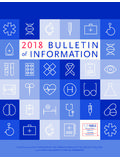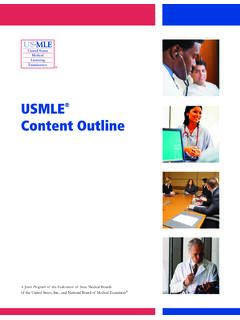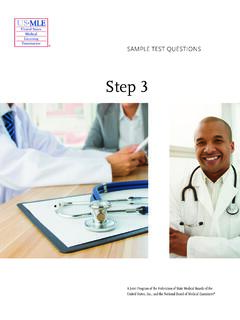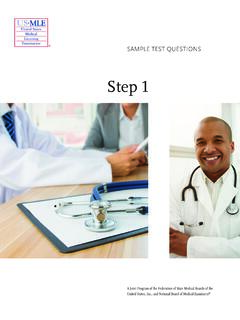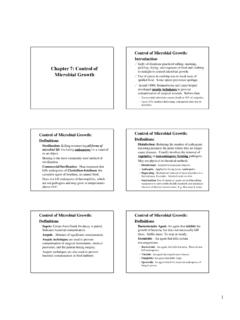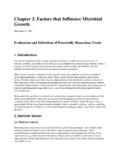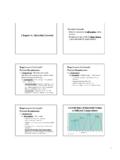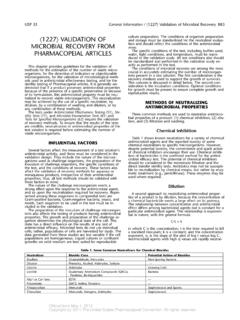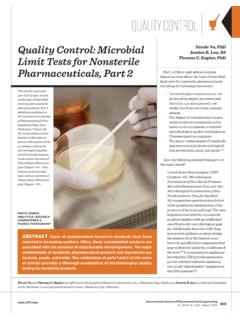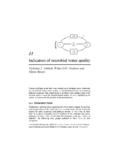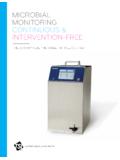Transcription of USMLE Content Outline
1 USMLE Content OutlineA Joint Program of the Federation of State Medical Boards of the United States, Inc., and the National Board of Medical Examiners This Outline provides a common organization of Content across all USMLE examinations. Each Step exam will emphasize certain parts of the Outline , and no single examination will include questions on all topics in the Outline . The examples listed within the Outline are just examples. Questions may include diseases, symptoms, etc., that are not included in the Outline . The USMLE program continually reviews its examinations to ensure their Content is relevant to the practice of medicine. As practice guidelines evolve or are introduced, the Content on USMLE is reviewed and modified as needed. At times, there is a change in emphasis on new Content development that arises from our ongoing peer-review processes.
2 For example, there has been an emphasis on new Content developed assessing competencies related to geriatric medicine, and prescription drug use and abuse. USMLE has also focused recent efforts on the often unrecognized health care needs of recently returning servicemen and servicewomen (eg, traumatic brain injury and post-traumatic stress disorder), and the families of deployed servicemen and servicewomen. While many of the medical issues related to the health care of these special populations are not unique, certain medical illnesses or conditions are either more prevalent, have a different presentation, or are managed differently. Knowledge of foundational science and clinical science in these Content areas will be assessed on the USMLE Step 1, Step 2 CK, and Step 3 examinations. Examinees should refer to the test specifications for each examination for more information about which parts of the Outline will be emphasized in the examination for which they are preparing.
3 See the USMLE website ( ) for more detail. Copyright 2020 by the Federation of State Medical Boards of the United States, Inc. (FSMB) and the National Board of Medical Examiners (NBME ). All rights reserved. The United States Medical Licensing Examination ( USMLE ) is a joint program of the FSMB and the NBME. 1 Table of Contents General Principles of Foundational Science 2 Immune System 4 Blood & Lymphoreticular System 5 Behavioral Health 7 Nervous System & Special Senses 8 Skin & Subcutaneous Tissue 11 Musculoskeletal System 12 Cardiovascular System 13 Respiratory System 15 Gastrointestinal System 16 Renal & Urinary System 18 Pregnancy, Childbirth, & the Puerperium 20 Female Reproductive System & Breast 21 Male Reproductive System 22 Endocrine System 23 Multisystem Processes & Disorders 24 Biostatistics, Epidemiology/Population Health, & Interpretation of the Medical Literature 27 Social Sciences 29 2 General Principles of Foundational Science Biochemistry and molecular biology Gene expression: DNA structure, replication, exchange, and epigenetics (eg, imprinting, X- activation, DNA methylation) Gene expression: transcription Gene expression.
4 Translation, post-translational processing, modifications, and disposition of proteins (degradation), including protein/glycoprotein synthesis, intra-extracellular sorting, and processes/functions related to Golgi complex and rough endoplasmic reticulum Structure and function of proteins and enzymes (eg, enzyme kinetics and structural/regulatory proteins) Energy metabolism (eg, ATP generation, transport chain) Biology of cells Adaptive cell responses and cellular homeostasis (eg, hypertrophy) Mechanisms of injury and necrosis, including pathologic processes (eg, liquefactive necrosis, free radical formation) Apoptosis Cell cycle and cell cycle regulation (eg, mitosis) Mechanisms of dysregulation cell biology of cancer (eg, role of p53, proto-oncogenes) general principles of invasion and metastasis, including cancer staging Cell/tissue structure, regulation, and function, including cytoskeleton, organelles, glycolipids, channels, gap junctions, extracellular matrix, and receptors Human development and genetics Principles of pedigree analysis inheritance patterns occurrence and recurrence risk determination Population genetics.
5 Hardy-Weinberg law, founder effects, mutation-selection equilibrium Principles of gene therapy Genetic testing and counseling Genetic mechanisms (eg, penetrance, genetic heterogeneity) Biology of tissue response to disease Acute inflammatory responses (patterns of response) acute inflammation and mediator systems (eg, histamine, prostaglandins, bradykinins, eosinophilic basic protein, nitric oxide) vascular response to injury, including mediators principles of cell adherence and migration (eg, ECAMs, selectins, leukocytic diapedesis, and rolling) microbicidal mechanisms and tissue injury (eg, defensins) clinical manifestations (eg, pain, fever, leukocytosis, leukemoid reaction, chills) Chronic inflammatory responses (eg, tumor necrosis factor) Reparative processes wound healing, repair: thrombosis, granulation tissue, angiogenesis, fibrosis, scar/keloid formation regenerative process Pharmacodynamic and pharmacokinetic processes: general principles Pharmacokinetics.
6 Absorption, distribution, metabolism, excretion, dosage intervals Mechanisms of drug action, structure-activity relationships (eg, anticancer drugs) 3 Concentration and dose-effect relationships (eg, efficacy, potency), types of agonists (eg, full, partial, inverse) and antagonists and their actions Individual factors altering pharmacokinetics and pharmacodynamics (eg, age, gender, disease, tolerance, compliance, body weight, metabolic proficiency, pharmacogenetics) Mechanisms of drug adverse effects, overdosage, toxicology Mechanisms of drug interactions Signal transduction, including structure/function of all components of signal transduction pathways such as receptors, ligands (eg, general principles of nitric oxide, autocrine and paracrine signaling) Microbial biology Microbial identification and classification, including principles, microorganism identification, and non-immunologic laboratory diagnosis Bacteria structure (eg, cell walls, composition, appendages, virulence factors, extracellular products, toxins, mechanism of action of toxins) processes, replication, and genetics (eg, metabolism, growth, and regulation) oncogenesis antibacterial agents (eg, mechanisms of action on organism, toxicity to humans, and mechanisms of resistance) Viruses structure (eg, physical and chemical properties, virulence factors) processes, replication, and genetics (eg, life cycles, location of virus in latent infection) oncogenesis antiviral agents (eg, mechanisms of action on virus, toxicity to humans, and mechanisms of resistance)
7 Fungi structure (eg, cell wall, composition, appendages, virulence factors, extracellular products, toxins, mechanisms of action of toxins) processes, replication, and genetics (eg, asexual vs. sexual, metabolism, growth) antifungal agents (eg, mechanisms of action on fungus, toxicity to humans, and mechanisms of resistance) Parasites structure (eg, appendages, macroscopic features, and virulence factors) processes, replication, and genetics (eg, life cycles, metabolism, and growth) oncogenesis antiparasitic agents (eg, mechanisms of action on parasite, toxicity to humans, and mechanisms of resistance) Prions Normal age-related findings and care of the well patient Infancy and childhood (0-12 years) Normal physical changes: linear growth, variations in linear growth, including constitutional delay; weight; head circumference; micturition, defecation, primary incontinence/bedwetting; normal physical examination; screening; sleep; teething syndrome Developmental stages: motor; speech; cognitive; psychosocial; anticipatory guidance Lifestyle and routine preventive health care: nutrition.
8 Exercise (eg, benefits of exercise); preventive/travel medicine; risk factors and prevention (eg, guns, swimming, motor vehicles, car seats); routine vaccinations 4 Adolescence (13-17 years) Normal physical changes: linear growth, variations in linear growth including constitutional delay; weight; puberty; normal physical examination; gynecomastia; autonomy/self-identity; sleep Developmental stages: cognitive (eg, abstract thought); psychosocial (eg, autonomy, role confusion, sexual identity); anticipatory guidance Lifestyle and routine preventive health care: nutrition; exercise (eg, benefits of exercise); preventive/travel medicine; risk factors and prevention (eg, risk-taking behavior, helmets, safe sex, motor vehicles, seat belts, distractions); routine vaccinations Adulthood (18-64 years) Normal physical changes: weight; normal physical examination; screening; sleep Developmental stages: cognitive; intimacy vs isolation; anticipatory guidance Lifestyle and routine preventive health care: nutrition; exercise (eg, benefits of exercise); preventive/travel medicine; risk factors and prevention; routine vaccinations Senescence (65 years and older) Normal physical changes, including normal physical exam for age: weight, height (spinal compression), skin, bruising; normal physical examination; response to temperature; micturition, defecation; sleep Developmental stages: motor; cognitive (eg, benign senescent forgetfulness); psychosocial; integrity vs despair; retrospection; anticipatory guidance Lifestyle and routine preventive health care: nutrition; exercise (eg, benefits of exercise); preventive/travel medicine; risk factors and prevention (eg, falls, general medical condition; polypharmacy, driving, caregiver stress).
9 Routine vaccinations Immune System Normal processes Development of cells of the adaptive immune response, including positive and negative selection during immune development Structure, production, and function granulocytes, natural killer cells, macrophages, mast cells, dendritic cells, cell receptors (eg, complement receptors and toll-like receptors), cytokines, chemokines T lymphocytes, including T-lymphocyte receptors, accessory molecules (eg, CD3, CD4, CD8, B7), cell activation and proliferation, cytotoxic T lymphocytes, and memory T lymphocytes B lymphocytes and plasma cells, including B-lymphocyte receptors, immunoglobulins, cell activation and proliferation, including development of antibodies and memory B lymphocytes host defense mechanisms, host barriers to infection, mucosal immunity (eg, gut- associated lymphoid tissue and bronchus-associated lymphoid tissue), anatomical locations of T and B lymphocytes Cellular basis of the immune response and immunologic mediators antigen processing and presentation in the context of MHC I and MHC II molecules (eg, TAP, beta-2 microglobulin), intracellular pathways, mechanisms by which MHC is expressed on the surface.
10 Including distribution of MHC I and MHC II on different cells, mechanisms of MHC I and MHC II deficiencies, and the genetics of MHC regulation of the adaptive immune response (eg, peripheral tolerance, anergy, 5 regulatory T lymphocytes, termination of immune response, and B-T lymphocyte interactions) activation, function, and molecular biology of complement (eg, anaphylatoxins) functional and molecular biology of cytokines (eg, IL 1-15) Basis of immunologic diagnostics (eg, antigen-antibody reactions used for diagnostic purposes, ELISA, immunoblotting, antigen-antibody changes over time, ABO typing) Principles of immunologic protection vaccine production and mechanisms of vaccine action biologically active antibodies (eg, monoclonal antibodies, polyclonal antibodies including IVIG, VZIG, rabies immunoglobulin) Effect of age on the function of components of the immune system Abnormal Processes: Health and Health Maintenance, Screening, Diagnosis, Management, Risks, Prognosis Disorders associated with immunodeficiency deficiency primarily of humoral immunity: common variable immunodeficiency; hyper IgM syndrome; hypogammaglobulinemia/agammaglobulinemia , X-linked (Bruton); selective immunodeficiency (eg, IgA, IgM, IgE) deficiency/dysfunction primarily of cell-mediated immunity: adenosine deaminase deficiency; DiGeorge syndrome; severe combined immunodeficiency disease (SCID); Wiskott-Aldrich syndrome; granulomatosis; allergic reactions/skin complement deficiency: alternative pathway component deficiency (C2, C3b, C3bB, C36B6); classical pathway component deficiency (C1q, C1r, C1-C5); terminal component deficiency (C5b-C9; terminal complement complex).

